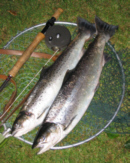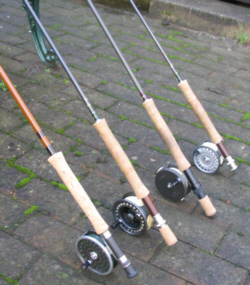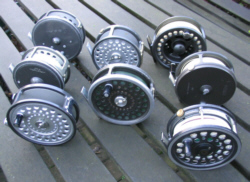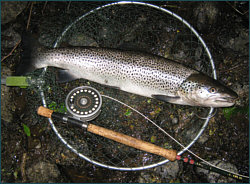Site Contents
Home
Salmon Fishing Scotland
Salmon - Where to Fish
Salmon Fishing Tackle
Salmon Fishing Tactics
Salmon Flies
Trout Fishing Scotland
Trout- Where to Fish
Trout Fishing Tackle
Trout Fishing Tactics
Trout Flies
Sea Trout Fishing Scotland
Sea Trout - Where to Fish
Sea Trout Tackle
Sea Trout Tactics
Sea Trout Flies
Fishing Maps of Scotland
Fishing Articles
Fly Tying
Fishing Photographs
Book of Flies
Fishing Diary
Where to Stay
Fishing Clubs
Fishing Tackle Shops
Fly Fishing Knots
Fishing Weather
Fishing Books
Salmon Recipes
Flies Online
Links
Sitemap
|
Brief Guide to
Sea Trout Fishing Tackle
 What
do we need then, in the way of fishing tackle, to catch the Scottish sea
trout, that mysterious migrant that comes in from the sea to spawn each
year, foregoing food while in our rivers? In some ways, the sea trout is
like both the salmon and the trout, in others, like neither. A difficult
fish to lure during the light of a summer's day, in all but spate
conditions, the sea trout will sometimes play the angler's game under
the cover of darkness. The sea trout fisher must then be, like the sea
trout, a nocturnal creature, venturing out at dusk and fishing through
the wee sma' oors of the night on a river running at or near summer low
level, often shrunken by summer drought. So what then do we need in the
way of sea trout fishing tackle. What
do we need then, in the way of fishing tackle, to catch the Scottish sea
trout, that mysterious migrant that comes in from the sea to spawn each
year, foregoing food while in our rivers? In some ways, the sea trout is
like both the salmon and the trout, in others, like neither. A difficult
fish to lure during the light of a summer's day, in all but spate
conditions, the sea trout will sometimes play the angler's game under
the cover of darkness. The sea trout fisher must then be, like the sea
trout, a nocturnal creature, venturing out at dusk and fishing through
the wee sma' oors of the night on a river running at or near summer low
level, often shrunken by summer drought. So what then do we need in the
way of sea trout fishing tackle.
Sea Trout Fly Fishing Tackle
Sea
Trout Fly Rods
The sea trout fisher's choice
of rod will again depend on the nature of his river, for, with the
notable exception of our famous sea trout lochs such as Maree, Stack,
More, Hope, Shiel, Eilt and Lomond, it is mainly in the river that we
hunt the sea trout. Sea trout run most of our rivers here in Scotland,
from the largest to the smallest, so our choice of tackle must suit the
circumstance. On a small river, a rod as short as nine feet might be
enough, but in general, on medium and large rivers, even with the river
at summer low, a better choice would be a rod of ten or ten and a half
feet, capable of handling large flies on a number seven or eight line. I
have always liked a rod with a through action and have used for many
years a rod built on a ten and a half feet Bruce and Walker Multitrout
rod blank, rated
6/7. This rod will comfortably cast any size of fly on a number seven or
eight double tapered line. I would say that an ideal all round sea trout
rod for night fishing on Scottish rivers would be a through actioned ten
foot rod paired with a double tapered number seven line.
Sea
Trout Fly Reels
The main requirement of a sea
trout reel is that it will hold a number eight floating
line (double tapered or weight forward) and a hundred yards of backing line. Such a reel is likely to have
a diameter of about three and three quarter inches and a spool width of
about one inch. Excellent examples of such a sea trout reel are to be
found in the Hardy Marquis #10 and the Hardy St Aidan or, if you can
find one, a Hardy St John Mk 2 (or Mk 1 if you wind with the
right hand). The J W Young's 1530 is also very good (or
Daiwa 809 or Shakespeare Beaulite in the same size) . To enable the
faster retrieval of line, many experienced sea trout fishers prefer a
geared "Multiplier" reel, such as the Hardy Marquis 8/9 multiplier or
the Young's 1500 series multiplier or Shakespeare Speedex reel, all
excellent sea trout reels with diameters of about three and
a half inches and with enough capacity to hold a number
eight line. Another reel worthy of consideration might
include the Sharpes Mentieth,
which can be used in silent mode, always useful for those who prefer the
quiet approach.
Trout
Fly Lines
Most keen sea trout fishers
will be familiar with Hugh Falkus's recommendation of having a variety
of line densities for varying conditions and times, a floating line for
early in the night, particularly in low water conditions, with the
option of additional lines with different sinking rates for high water
or when the sea trout have "gone down" late in the night. Requirements
will vary depending on the river but, on the rivers I have fished, I
would say that about eighty percent of my fishing is done with a
floating line, a double tapered line in size seven or eight. An
intermediate line or line with a sink tip is useful when the river is
running slightly high or for later in the night when temperatures fall.
I rarely use a full sinker, although I acknowledge that this omission
may, on occasion, cost me the chance of a fish. In general, I will feel
fairly well equipped if I arrive on a sea trout river with a floating
line and an intermediate line, plus a few sink tips in a variety of
lengths and densities, cut from a few mill end lines. As for the
flies.....see
sea-trout flies |
Sea Trout Fly Rods
|
|
 |
|
|
Sea Trout Fly Reels
|
|
 |
|
|
Sea Trout Net
|
|
 |
|
|